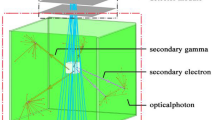Abstract
Muon tomography is a capable imaging technique to measure the geometry of high-Z objects. However, most existed algorithms used in muon tomography have obscured the effects of angular distribution and momentum spectra of cosmic ray muons and reduced the spatial resolution. We present a modified multi-group model that takes into account these effects and calibrates the model by the material of lead. Performance tests establish that the model is capable of measuring the thickness of a Pb slab and identifying the material of an unknown slab on a reasonable exposure timescale, in both cases of complete and incomplete angular data. Results show that the modified multi-group model is helpful for improvements in image resolution in real applications.




Similar content being viewed by others
References
K.N. Borozdin, G.E. Hogan, C. Morris et al., Surveillance: radiographic imaging with cosmic-ray muons. Nature 422(6929), 277 (2003). https://doi.org/10.1038/422277a
L.J. Schultz, K.N. Borozdin, J.J. Gomez et al., Image reconstruction and material \(Z\) discrimination via cosmic ray muon radiography. Nucl. Instrum. Methods A 519, 687–694 (2004). https://doi.org/10.1016/j.nima.2003.11.035
W.C. Priedhorsky, K.N. Borozdin, G.E. Hogan et al., Detection of high-\(Z\) objects using multiple scattering of cosmic ray muons. Rev. Sci. Instrum. 74, 4294–4297 (2003). https://doi.org/10.1063/1.1606536
R.C. Hoch, Master thesis, Florida Institute of Technology (2009)
J. Perry, Ph.D. thesis, University of New Mexico (2013)
J.O. Perry, J.D. Bacon, K.N. Borozdin et al., Analysis of the multigroup model for muon tomography based threat detection. J. Appl. Phys. 115, 064904 (2014). https://doi.org/10.1063/1.4865169
J. Snuverink, The ATLAS Muon Spectrometer: Commissioning and Tracking (University of Twente, Enschede, 2009)
M. Bandieramonte, V.A. Delogu, U. Becciani et al., Automated object recognition and visualization techniques for muon tomography data analysis, in 2013 IEEE International Conference on Technologies for Homeland Security (HST), Institute of Electrical and Electronics Engineers (IEEE) (2013). https://doi.org/10.1109/THS.2013.6699057
M. Furlan, A. Rigoni, S. Vanini et al., Application of muon tomography to detect radioactive sources hidden in scrap metal containers. IEEE Trans. Nucl. Sci. 61, 2204–2209 (2014). https://doi.org/10.1109/TNS.2014.2321116
R. Patnaik, Y. Lee, D. Dorroh, Image based object identification in muon tomography, in 2014 IEEE Nuclear Science Symposium and Medical Imaging Conference (NSS/MIC) (Institute of Electrical and Electronics Engineers (IEEE), 2014). https://doi.org/10.1109/NSSMIC.2014.7431145
G. Blanpied, S. Kumar, D. Dorroh et al., Material discrimination using scattering and stopping of cosmic ray muons and electrons: Differentiating heavier from lighter metals as well as low-atomic weight materials. Nucl. Instrum. Methods A 784, 352–358 (2015). https://doi.org/10.1016/j.nima.2014.11.027
M. Sossong, G. Blanpied, S. Kumar et al., Cosmic ray generated charged particles for cargo inspection, in NATO Science for Peace and Security Series B: Physics and Biophysics, Nuclear Threats and Security Challenges (2015), pp. 229–243. https://doi.org/10.1007/978-94-017-9894-5_21
C.L. Morris, K. Borozdin, J. Bacon et al., Obtaining material identification with cosmic ray radiography. AIP Adv. 2, 042128 (2012). https://doi.org/10.1063/1.4766179
C.T. Case, E.L. Battle, Molière’s theory of multiple scattering. Phys. Rev. 169, 201–204 (1968). https://doi.org/10.1103/PhysRev.169.201
W.T. Scott, The theory of small-angle multiple scattering of fast charged particles. Rev. Mod. Phys. 35, 231–313 (1963). https://doi.org/10.1103/RevModPhys.35.231
C.L. Morris, J. Bacon, K. Borozdin et al., A new method for imaging nuclear threats using cosmic ray muons. AIP Adv. 3, 082128 (2013). https://doi.org/10.1063/1.4820349
C. Bai, S. Simon, J. Kindem et al., Muon tomography imaging improvement using optimized limited angle data, Proceedings of SPIE 9073, Chemical, Biological, Radiological, Nuclear, and Explosives (CBRNE) Sensing XV, 907318 (2014). https://doi.org/10.1117/12.2049977
C. Hagmann, D. Lange, D. Wright, Cosmic-ray shower generator (CRY) for Monte Carlo transport codes, in IEEE Nuclear Science Symposium Conference Record, vol. 2007, no. 2 (2007), pp. 1143–1146. https://doi.org/10.1109/NSSMIC.2007.4437209
S. Agostinelli, J. Allison, K. Amako et al., Geant4—a simulation toolkit. Nucl. Instrum. Methods A 506, 250–303 (2003). https://doi.org/10.1016/S0168-9002(03)01368-8
J. Allison, K. Amako, J. Apostolakis et al., Geant4 developments and applications. IEEE Trans. Nucl. Sci. 53, 270–278 (2006). https://doi.org/10.1109/TNS.2006.869826
D. Mitra, A. Banerjee, S. Waweru et al., Simulation study of muon scattering for tomography reconstruction, in IEEE Nuclear Science Symposium Conference Record (NSS/MIC) (2009). https://doi.org/10.1109/NSSMIC.2009.5402209
Author information
Authors and Affiliations
Corresponding author
Additional information
This work was supported by the Science and Technology Development Foundation of CAEP (No. 2015B0103014) and the National Natural Science Foundation of China (No. 11605163).
Rights and permissions
About this article
Cite this article
Xiao, S., He, WB., Lan, MC. et al. A modified multi-group model of angular and momentum distribution of cosmic ray muons for thickness measurement and material discrimination of slabs. NUCL SCI TECH 29, 28 (2018). https://doi.org/10.1007/s41365-018-0363-7
Received:
Revised:
Accepted:
Published:
DOI: https://doi.org/10.1007/s41365-018-0363-7




